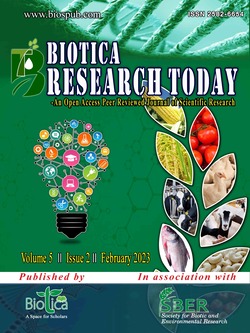
Activity of Nanoparticles on Plant Growth and Development
Gnana Vinoba A.
Karunya Institute of Technology and Sciences, Karunya Nagar, Coimbatore, Tamil Nadu (641 114), India
DOI: NIL
Keywords: Antioxidant activity, Nanoparticles, Photosynthesis, Plant growth and Development
Abstract
Nanotechnology has emerged as a promising field, with applications in agriculture, food, and medicine. Because of their non-threatening use in agriculture, nanoparticles such as titanium dioxide (TiO2), iron oxide (Fe3O4), zinc oxide (ZnO), silicon oxide (SiO2), copper (Cu-NPs), and selenium (Se-NPs) have recently received significant attention. Nanoparticles can be produced using a variety of methods, including chemical, green, and physical processes. Plant growth and development are aided by nanoparticles; however, these effects vary depending on the origin, size, concentration, and time of application to crops. Nanoparticles have recently improved plant tolerance to biotic and abiotic stresses. Nanoparticles protect plants from oxidative damage by increasing antioxidant activity. Nanoparticles can help to reduce the toxic effects of drought.
Downloads
not found
Reference
Mahajan, P., Dhoke, S.K., Khanna, A.S., 2011. Effect of Nano-ZnO Particle Suspension on Growth of Mung (Vigna radiata) and Gram (Cicer arietinum) Seedlings Using Plant Agar Method. Journal of Nanotechnology 2011, 1-7. DOI: https://doi.org/10.1155/2011/696535.
Siddiqui, M.H., Al-Whaibi, M.H., Faisal, M., Al Sahli, A.A., 2014. Nano-silicon ioxide mitigates the adverse effects of salt stress on Cucurbita pepo L. Environmental Toxicology and Chemistry 33(11), 2429-2437. DOI: https://doi.org/10.1002/etc.2697.
